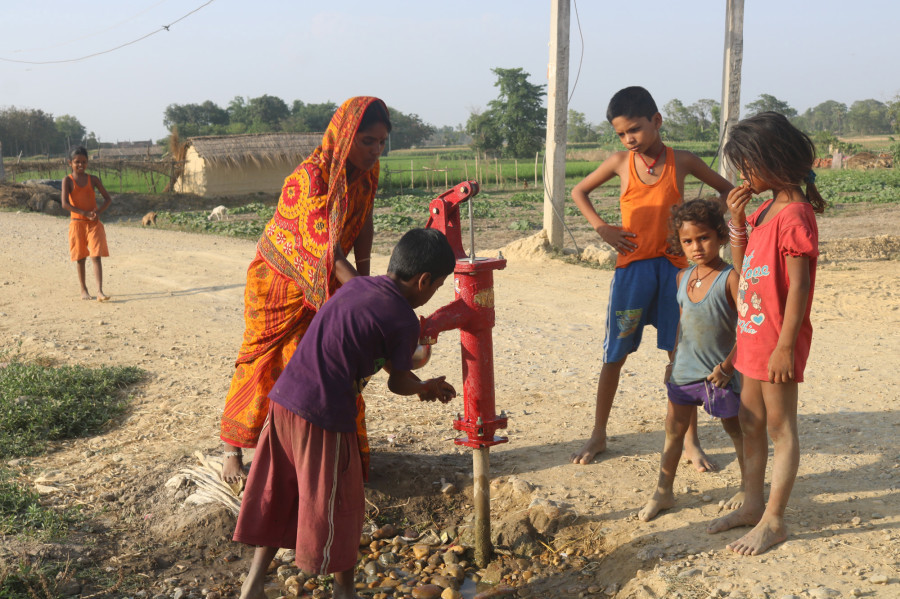Columns
Recharging groundwater
Constructing storage dams or mobilising groundwater is necessary to unlock irrigation’s full potential.
Dinesh Panday
If you recently drank a cup of coffee, you likely did not consider the amount of water used to produce it. Zooming out to a broader perspective, considering that we require around 500 kg of food per person annually, have you thought about the water consumption linked to food production? Doing so could be a good start.
A cup of coffee requires 140 litres of water to grow, process and transport beans. Depending upon the climate at the place of production and yields per area, the large volume of water to grow coffee plants comes from rainwater or surface/ groundwater. On average, a Nepali resident’s daily water footprint, including direct and indirect consumption, is around 1,700 litres. As the planet does not have an endless water supply, a growing population and the impact of climate change are steering us to a future where water demand will surpass its supply.
Country profile overview
As of the National Agricultural Census 2021/22, Nepal occupies 2.2 million hectares of agricultural land. Notably, 54.5 percent of this land is irrigated, with an estimated 72.7 percent irrigable throughout the year. Over the past decade, irrigated land experienced a slight increase of 2.5 percent. Several factors contribute to this rise, such as improved irrigation infrastructure, the adoption of water-efficient modern irrigation technologies, and government initiatives and policies supporting agricultural development, including irrigation projects.
There are around 6,000 rivers in Nepal, with three main river basins, namely Koshi, Narayani and Karnali. Most irrigation systems rely on medium or small rivers, heavily dependent on rainfall. The annual surface volume is estimated at 173,000 million cubic metres, and the groundwater volume is around 13,072 million cubic metres. These numbers suggest the available water volume could irrigate 6.9 million hectares of land. However, over 70 percent of this resource is available between June and September, when irrigation demand is low. Outside this period, the water can only irrigate 0.75 million hectares of land due to reduced flows.
To unlock its full potential, constructing storage dams or mobilising groundwater is necessary. The purpose of constructing storage dams is not only to capture a substantial amount of water during the monsoon season but also to make it available throughout the non-monsoon period. In addition, these dams play a major role in mitigating floods in the low-lying regions of Terai. Nepal faces an annual soil erosion of 0.5–1 mm, primarily due to flooding and sedimentation in downstream rivers.
Groundwater outlook
Throughout history, there has been a belief that groundwater resources are naturally abundant and eternally accessible for human exploitation. Groundwater in Tarai originates from rainwater infiltration (water movement across the ground surface into the soil) and lateral recharge from the Bhabar zone, along the Siwalik foothills. Water-bearing soil, sand and rock formations are known as aquifers, which can absorb and transmit water. Rainfall naturally recharges most of the aquifers. In addition, sub-surface inflow and seepage losses from streams and rivers also contribute to the recharging process. Aquifer properties can differ across regions. For example, inner Tarai valleys like Dang, Deukhuri and Chitwan feature larger rivers and coarse sediment deposits, allowing quick aquifer recharge. In contrast, Surkhet Valley, also part of the inner Terai but with finer sediments, demonstrates low groundwater availability.
Groundwater emerges as a swift solution for expanding irrigation coverage in the short term due to its rapid construction, limited command area and lower energy demands. Since 1980, the Government of Nepal has initiated programmes to develop groundwater irrigation in the Tarai region by providing subsidies in various forms. Currently, groundwater plays a pivotal role in irrigating 20 percent of cropland, primarily in Tarai and inner valleys. The Ministry of Energy, Water Resources and Irrigation has implemented several programmes and projects under the Groundwater Resources Development Board, such as the Groundwater Irrigation Project. This project runs in all 20 districts in Tarai and provides irrigation for 20,465 hectares using shallow and deep tubewells. Similarly, the Irrigation Master Plan 2019 prioritises groundwater development more than current surface irrigation schemes when considering the same benefits because of maintenance and management issues in existing surface irrigation systems.
Groundwater depletion
Groundwater depletion is the extended and consistent lowering of water levels due to continuous groundwater pumping activities. While there is a lack of specific field-based research data indicating a decline in groundwater availability for agriculture in Nepal, various news articles and personal communication highlight concerns about water resources. The primary recharge zone in Tarai is increasingly vulnerable due to industrial and agricultural activities, as well as human interventions such as deforestation, unregulated mining of stones and sand, and massive forest exploitation, which have not been adequately addressed.
My observations in specific regions, Sarlahi and Sihara districts, reveal a concerning trend. Those farmers who were using deep boreholes for vegetable cultivation in upland areas have seen water sources dry up over the past decade. Around two decades ago, water could be extracted from depths of 10-15 metres. This observation strongly suggests a gradual depletion of available groundwater sources because the amount of groundwater extraction over the years has been greater than the natural replenishment capacity. In Kathmandu Valley, the extraction rate is six times higher than the recharge capacity, resulting in an annual decline of around 2.5 metres in the groundwater table.
The government provides subsidies to help farmers extract groundwater for better crop yields, which include support for solar-powered pumps, cost assistance for shallow tubewells and reduced electricity charges for deep tubewells. While the country aims to make the nation self-sufficient in food, enhancing crop production/ agricultural intensification is associated with excessive use of agrochemicals, including chemical fertilisers and pesticides. These activities also intensify water use, and there would be more demand for water. Hence, farmers often over-pump groundwater, worsening the water scarcity problems. Though agricultural policies were executed to support farmers and crop production, a structural problem embedded in policies exacerbated the water scarcity problems and depleted aquifers.
Groundwater contamination risks extend beyond groundwater extraction, with the potential for pollutants like nutrients and pesticides to infiltrate. Nitrogen fertilisers and field-applied manures pose a heightened risk, particularly in areas with shallow-rooted crops like onions and potatoes on coarse-textured soil. Nitrate, released from these fertilisers, can easily migrate from the application zone into the groundwater. Shallow and deep aquifers in the Kathmandu Valley face challenges due to toxic heavy metals and high microbial contamination. Notably, water sample tests in Panchkhal Municipality, which experienced intensified commercial agricultural activities, revealed traces of synthetic pyrethroid and carbamate. Unfortunately, the damage often becomes apparent only when it is already too late to correct.
The bottom line
Utilising Nepal’s untapped groundwater efficiently requires adopting water-saving technologies and management practices, such as drip and sprinkler irrigation. This often requires adjusting the cropping systems, optimising fertiliser use, and selecting crops with lower water footprints like millet. Even for rice production, widely known as a high water-requiring crop, the system of rice intensification (SRI) stands out as an innovative method that minimises seedings and water consumption. However, proficiency in the production technique is required for successful adoption, as a lack of expertise and a limited market can result in labour-intensive processes and system failure.
Water-saving techniques are necessary not only for making groundwater irrigation profitable but also to minimise stress on the groundwater resources, allowing sufficient time for recharge. These techniques can reduce the negative impact on soil health and sustain the environment. Success in groundwater management aligns with the principles of “more crop per drop” and “more value from every drop”, echoing the theme of 2023 World Soil Day: “Soil and Water: A Source of Life”.




 5.4°C Kathmandu
5.4°C Kathmandu













%20(1).jpg&w=300&height=200)

